Outside's long reads email newsletter features our strongest writing, most ambitious reporting, and award-winning storytelling about the outdoors. Sign up today.
Outdoor enthusiasts are more subject than most to having to deal with a vehicle breakdown in a remote location where immediate help may not be available. Since tire punctures are by far the most common problem a vehicle will experience—and something more likely to happen on dirt roads—and since you can’t always count on your spare tire, it makes sense for us to arm ourselves with the tools and knowledge it takes to repair them ourselves. Here’s how.
How Do You Know You’ve Got a Puncture?On a paved road, if your steering wheel starts to wobble vaguely in your hands, or if you hear a loud thumping sound that coincides with your wheels’ rotation, then you’ve got a flat tire. Off-road, at lower speeds, you’ll likely hear that thumping before you feel it.
In both cases, avoid risking further damage to the tire or vehicle by finding the first safe location to pull off the road or trail.
Video loading...
Don’t Rely on Your SpareIt’s become less and less common for new vehicles to come equipped with a full-size spare tire. Space savers, or donuts, are only designed to get you a very short distance at very low speeds—across town to the tire shop, basically. You should avoid using a space saver on a dirt road or trail if at all possible.
And even if you have a full-size spare with a matching tire and wheel, it’s still possible to puncture more than one tire at a time. And man, that’s going to cause a big problem if you’re not prepared or if it happens somewhere you can’t easily call for help.
What You NeedThe tools you should have to fix a flat tire yourself don’t cost much more than getting a tire plugged at a tire shop. And they’re hundreds of dollars cheaper than calling for a tow. They’re also small and light.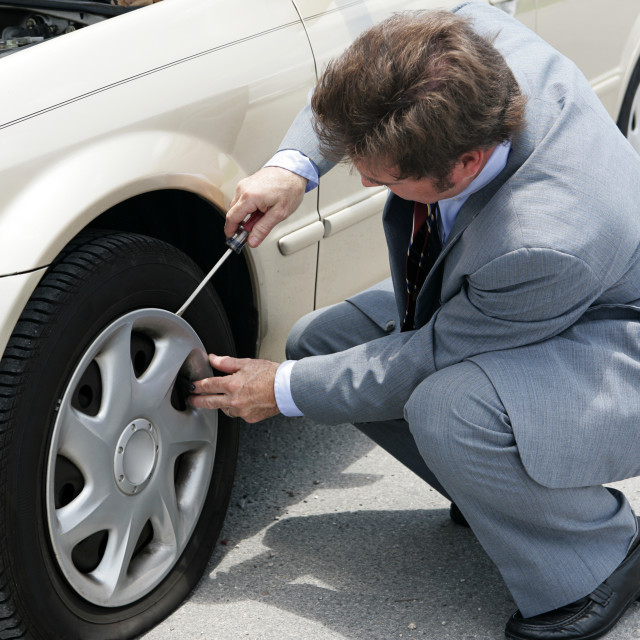 There’s really no excuse for not carrying this stuff in your car or truck.
There’s really no excuse for not carrying this stuff in your car or truck.
The best tire-repair kit I’ve found is made by Boulder Tools and costs $38. Like other kits, it includes rope plugs and the tools you need to install them, but this one goes above and beyond by including items like needle-nose pliers, spare valve cores, and a folding razor blade.
You will also need a compressor. That’s what you’ll use to reinflate your tire after you fix the puncture, or how you’ll air back up to road pressures if you’re airing down for off-road driving. If all you need is an emergency option, one of these $23 Slime compressors is perfect. It plugs into your cigarette lighter (or 12-volt outlet), so you don’t even need to open your hood. You don’t want to rely on something like this if you’re regularly inflating oversize off-road tires, but that’s a story for another time.
I also stick a can of Fix-a-Flat in every car my family owns, plus those of most of my friends. Fix-a-Flat includes both a sealant and compressed air in a single can, allowing you to take care of the kind of small punctures caused by a screw or nail without even removing the wheel. And that capability makes it a unique tool in your arsenal—one that can come in handy for even complicated repairs where it’s not safe to to try and remove a wheel or where gaining the ability to roll the car a few hundred yards can make the situation much safer (think: a steep slope off-road or the side of a busy highway, with trucks rushing past just feet away).
Fix-a-Flat includes both a sealant and compressed air in a single can, allowing you to take care of the kind of small punctures caused by a screw or nail without even removing the wheel. And that capability makes it a unique tool in your arsenal—one that can come in handy for even complicated repairs where it’s not safe to to try and remove a wheel or where gaining the ability to roll the car a few hundred yards can make the situation much safer (think: a steep slope off-road or the side of a busy highway, with trucks rushing past just feet away).
Everyone should also carry a quality tire-pressure gauge. Use it to check the pressure of your tires once a month, and adjust them to factory-recommended settings if they’re off. Ambient temperatures, elevation, and just time can all cause a tire to lose or gain pressure, and when it does so, it can harm your fuel economy, handling, and performance.
Avoid TroubleRegularly inspect your tires and replace them before the tread wears to 2/32nd of an inch deep.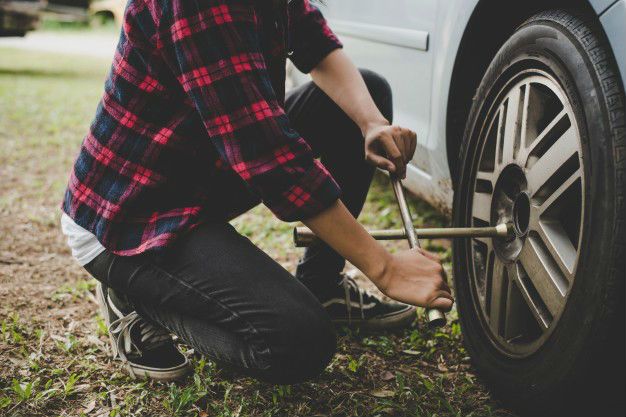 An easy way to check this is to insert a penny upside down into the tread (Lincoln’s head first). If the tread reaches past Honest Abe’s hairline at his forehead, you’re good. If not, order new tires. Tires worn to or past 2/32nd of an inch of tread will be much more prone to punctures and won’t provide the same grip as a tire in good condition.
An easy way to check this is to insert a penny upside down into the tread (Lincoln’s head first). If the tread reaches past Honest Abe’s hairline at his forehead, you’re good. If not, order new tires. Tires worn to or past 2/32nd of an inch of tread will be much more prone to punctures and won’t provide the same grip as a tire in good condition.
Tires also have a maximum life span of six years. To determine how old your tires are, look for the tire identification number on the sidewall: it begins with DOT, is 11 digits long, and ends in four numbers. The first two digits of those last four numbers represent the week (of 52 in a year) the tire was manufactured. The last two are the year.
If your tire shows any signs of cracking or tearing, or if anything white or metallic has worn through the rubber, replace it immediately.
You also need to make sure you’re using an appropriate tire for the conditions you’re facing. If you’re traveling off pavement, a quality all-terrain tire will help you avoid punctures both in the tread and, more importantly, the sidewall.
Make sure any vehicle you’re driving has all of the necessary tire-change tools present and accounted for. You’ll need a lug wrench and a jack at a minimum. Don’t be that person who forgets to put them back into a car. I even check for these things in rental cars before driving off—they’re that essential.
Right in the middle of your tread is a good place to find a foreign object. (Nathan Norby)Step One: Find the PunctureOnce you’re in a safe place, hop out of the car, and find the flat tire. Try to identify the source of the puncture. Sometimes a foreign object will be very obvious at just a glance. Sometimes you’ll need to roll the car a foot or two to expose the problem.
If you are able to see that there’s obviously a nail or screw embedded in your tire’s tread, that’s good news. If the nail or screw is strongly embedded into the tire’s tread, there’s no need to remove it at this time. Get out your can of Fix-a-Flat, follow its directions to connect it to your tire valve, and empty the entire contents of the can into the tire. You should see the tire visibly inflate. If it returns to normal, drive off immediately, go a few miles, then stop and check your tire pressure, adjusting it if necessary. If the tire seems to be holding air, you’re good to continue driving, but take a look at the tire any time you stop. When you get back from your trip and have the time, go ahead and follow the rest of the steps here to repair the puncture with a plug.
You should see the tire visibly inflate. If it returns to normal, drive off immediately, go a few miles, then stop and check your tire pressure, adjusting it if necessary. If the tire seems to be holding air, you’re good to continue driving, but take a look at the tire any time you stop. When you get back from your trip and have the time, go ahead and follow the rest of the steps here to repair the puncture with a plug.
If you can’t find the source of the puncture, if it’s an exposed hole, or if you don’t have a can of Fix-a-Flat, you’ll need to take the wheel off.
Step Two: Remove the WheelFirst, remove your spare (even if it’s a space saver), and place it under the frame of your vehicle in front of the front tire or behind the rear tire. That way, if your vehicle falls off its jack, it will fall onto the spare, minimizing injury to you and damage to the car.
Loosen the lug nuts before you raise the vehicle. Remember: lefty loosey.
Next, follow the instructions in your owner’s manual to locate and use the jack accordingly.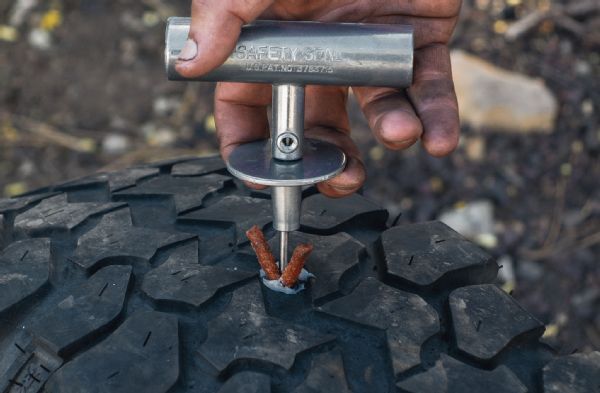
Once the wheel is off the ground, finish removing the lug nuts. Put them somewhere safe. Pull the wheel out toward your body. Be careful—wheels can be heavy.
Step Three: Evaluate the PunctureIf you have a hole in your tread, it can be fixed. Tires in good condition won’t experience more than a simple hole in that location. If the hole is in your sidewall (the portion of the tire that rides roughly vertical), you just need to mount your spare and have the tire replaced at the first possible opportunity.
If the hole is in the tire’s tread and can’t be taken care of by simply dumping a can of Fix-a-Flat into it, roll the tire around to the back of your vehicle where tools are and where you can safely work away from traffic. Look for holes and foreign objects as you roll it. If a hole is small and the tire is no longer leaking air, it may be a good idea to mark the hole for easy reference later.
The recommended kit includes these needle-nose pliers; otherwise, a multitool is a good stand-in.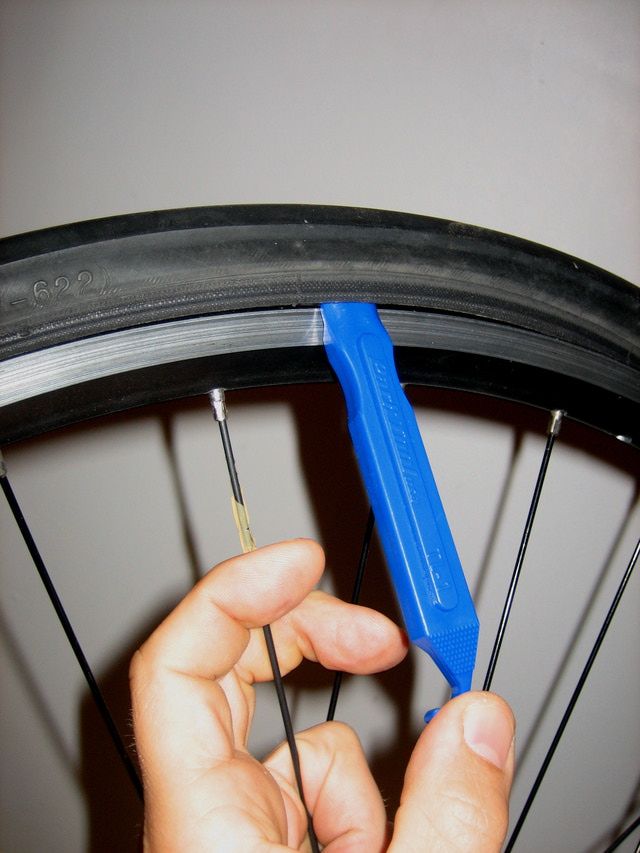 (Nathan Norby)Step Four: Remove the Problem
(Nathan Norby)Step Four: Remove the ProblemIf there’s a foreign object in your tire, and the tire can no longer hold air, remove it. In the video, I used a screw gun to put the screw in the tire, meaning its threads engaged with the rubber and steel belts. Most roads don’t have their own screw guns, so the puncture won’t engage the threads in the same way, and it should be easier to pull out using your needle-nose pliers.
I’ve seen tires punctured by everything from a steel bar to a particularly nasty cactus barb. Organic objects like tree branches can leave residue behind. Try and get all of that out of the way.
The reaming tool will slowly enlarge and clean the hole. (Nathan Norby)Step Five: Enlarge the HoleIf the hole is larger than a pencil, skip this step. If not, grab your tire-repair kit’s reamer, and use it to enlarge the hole until it is roughly the size of a pencil.
If you have a very small hole, this will be difficult at first. Install the reaming tool by slowly screwing it into the tread while applying downward pressure. Otherwise, just push the tool into the hole all the way up to the handle, then yank it out. Repeat until the hole is large enough that you can insert and remove the tool without much effort.
Install the reaming tool by slowly screwing it into the tread while applying downward pressure. Otherwise, just push the tool into the hole all the way up to the handle, then yank it out. Repeat until the hole is large enough that you can insert and remove the tool without much effort.
Remove a rope plug from the plastic wrapper, flatten one end with the needle-nose pliers, and push it through the eyelet on the installation tool. Grasp the protruding edge of the plug with the pliers, and pull it through the eyelet until equal lengths of the plug protrude from both sides.
Grab a finger of lube from the kit, and apply it to the plug and leading edge of the tool.
Firmly push the installation tool in as far as it will go, then yank it out as hard as you can. (Nathan Norby)
(Nathan Norby)Place the tool tip down on top of the hole in the tire, grasp the tool securely with both hands, and force it through the tire until the depth guide is flush with the tread. Then yank the tool straight out of the hole as hard and fast as you can. The rope plug should pass through the eyelet and remain inside the tire.
The plug should remain in the tire when you yank the tool out. Now just trim off that excess length. (Nathan Norby)If you have only a small puncture, one plug should do. If not, you may need to install a second or third. If you must install multiple plugs, then plan on taking that tire to a shop the first possible opportunity, where it can be evaluated for safety. You may have to replace it. But most of the time, that single plug will be enough. Use the razor to trim the excess length flush with the tire tread.
If your tire holds air up to the recommended pressure, then odds are it’s going to be good to go. Just check the pressure again after a few miles to make sure.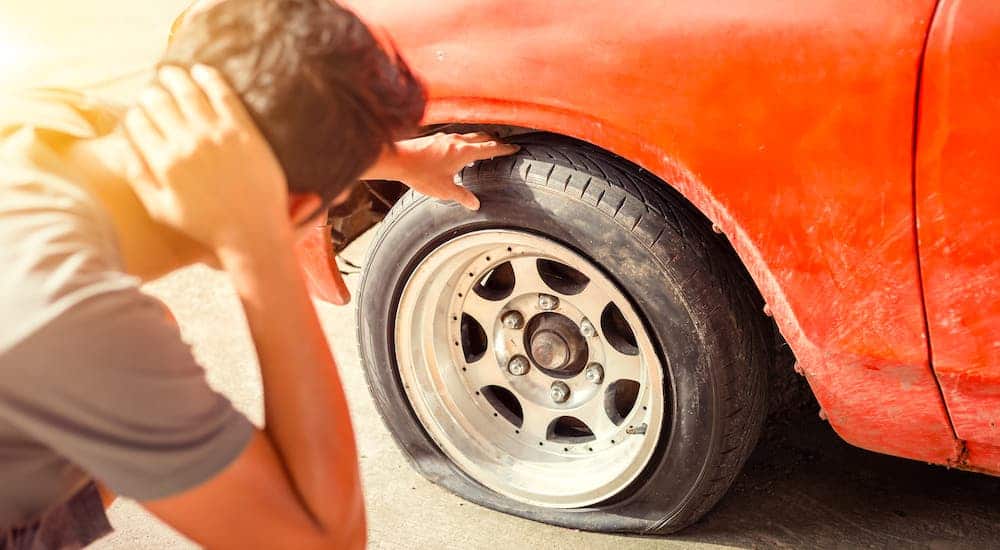 If for some reason you’re losing a little air around the plug, try adding Fix-a-Flat. (Nathan Norby)Step Eight: Reinstall the Wheel
If for some reason you’re losing a little air around the plug, try adding Fix-a-Flat. (Nathan Norby)Step Eight: Reinstall the WheelUse your air compressor to inflate the tire to the recommended pressure. (You’ll find that listed inside the driver’s doorjamb.) Once inflated, reverse the tire-removal steps described above to reinstall the wheel. First, install the lug nuts by hand to secure the wheel to the hub. Then, once you’ve lowered the vehicle back down and removed the jack, use the lug wrench to make sure all the lug nuts are as tight as possible. Tighten them in a star pattern, so the wheel snugs back to the hub evenly. Remember: righty tighty. Check these again later that day.
Return all your tools, the jack, and the lug wrench to their proper locations. You’d don’t want to misplace this stuff.
And that’s it. No tow truck. No hiking out a dirt road in search of help. No waiting on AAA while sitting on the side of a busy highway. No huge expense. And no more than a few minutes of hard work.
So, you have a flat tire or one that’s leaking air. It’s not the end of the world. Luckily there are safe and cost-effective ways to properly repair most tire punctures. The purpose of this article is to show you the difference between a safe, permanent repair and a temporary string, plug or patch repair.
According to the National Highway Traffic Safety Administration (NHSTA) and the Tire Industry Association (TIA), the only method to properly repair a tire puncture is to fill the injury with a repair stem and back the stem with a repair patch. This is commonly known as a combination repair or a patch/plug repair.
Patch/plug repairs are most often performed using a one-piece repair unit that combines the repair stem and cap (or patch) into one unit. However, special circumstances may require the use of a two-piece combination repair (ex. If the angle of the puncture exceeds 35 degrees).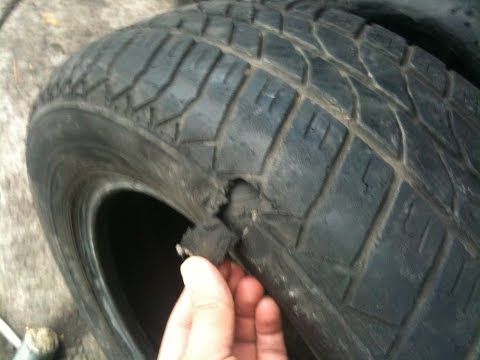 The repair is then permanently bonded to the inside of tire and through the injury channel using a cold, chemical vulcanizing process. The repair essentially becomes part of the tire, creating an air-tight seal that keeps air in and moisture and contaminants out (more on this procedure below).
The repair is then permanently bonded to the inside of tire and through the injury channel using a cold, chemical vulcanizing process. The repair essentially becomes part of the tire, creating an air-tight seal that keeps air in and moisture and contaminants out (more on this procedure below).
Emergency roadside plug repairs are NOT intended to be a permanent tire repair. Plugs and string repairs are designed to get you back up and rolling long enough to get home or to the nearest service center to perform a proper tire repair.
The common misconception with plug and string repairs is that because they hold air, they are safe to use. While it is true that many plug repairs do a great job of keeping air in the tire, that’s only part of the equation. Because they’re not completely sealing the injury, plug repairs may allow air and moisture to penetrate the body of the tire. Over time, this could lead to a dangerous (or even deadly) blowout.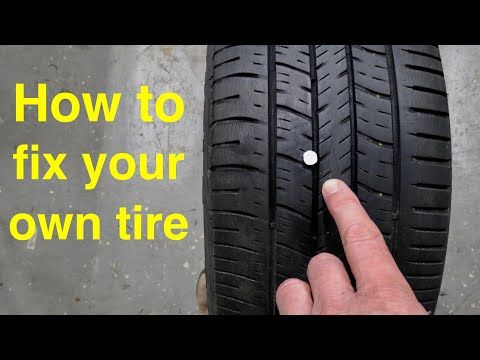
A tire repair that uses only a patch is also NOT considered proper or safe. A properly installed patch will do a great job of allowing the tire to hold air. However, similarly to the plug-only repair, the patch does not fill the injury channel. Therefore, air and moisture could seep into the tire from the tread surface and eventually damage the tire.
The Proper Tire Repair Process According to Industry GuidelinesOnly a proper patch/plug repair completely seals the puncture from inside the tire and through the entire injury channel. There are a few extra steps necessary to perform a proper tire repair in accordance with industry guidelines. We’ve developed a simple acronym to help organize and remember the steps: R.E.P.A.I.R.

 The over-buffed area of the inner liner is treated with a thin layer of rubber sealant, and the excess repair is trimmed to approximately ¼” above the tread surface.
The over-buffed area of the inner liner is treated with a thin layer of rubber sealant, and the excess repair is trimmed to approximately ¼” above the tread surface.There are a number of factors that may determine whether or not your tire is safe to repair. These factors fall into three main categories:
 Excessive wear, casing separation, impact damage and other conditions may make it unsafe to properly repair your tire. For a more comprehensive list of repairable vs. non-repairable conditions visit our blog Can Your Tire Be Repaired?
Excessive wear, casing separation, impact damage and other conditions may make it unsafe to properly repair your tire. For a more comprehensive list of repairable vs. non-repairable conditions visit our blog Can Your Tire Be Repaired?The occasional flat or leaky tire is an unavoidable part of life. But, taking shortcuts to repair it can be dangerous to you and your passengers. Take the time and do the research to do the job right and/or find a reputable tire repair shop trained in proper tire repair procedure.
Author: Aleksey Kokorin
Experienced drivers are not surprised by such a trifle as a puncture, but for the first time beginners usually get confused in the sequence of actions, forget about important details and do not know what to do with a punctured wheel even in a tire shop - especially if they start offering choose from several options or intimidate with expensive repairs. Let's set up an operation algorithm when a flat tire is detected and figure out what to do right away and what to choose later.
Let's set up an operation algorithm when a flat tire is detected and figure out what to do right away and what to choose later.
What to do when you find a puncture
Having found a flat tire, first of all you need to stop in a safe place, turn on the alarm, assess visibility and, if necessary, set an emergency stop sign: according to traffic rules, it is installed at least 15 meters from the car in the village and at least 30 meters outside the settlement. When choosing where to stop, consider the space to the side of the vehicle to handle a flat tire. You should not stop right on the road and in places where stopping and parking are prohibited: even if a punctured wheel belongs to the conditions of a forced stop, it is quite possible to drive several tens of meters on it to choose a safe and convenient parking place. At night or in conditions of limited visibility (for example, in fog or rain), it is imperative to wear a vest with retroreflective elements - this is required by clause 2. 3.4 of the SDA and common sense.
Now you can start working on the wheel. We will sequentially consider several options for action, and then move on to ways to repair a damaged tire.
The most obvious solution to a flat tire is to replace it. If you have a spare tire that you are sure is in good condition, the best option is to install it and visit a tire shop to repair a punctured tire - such repairs will be more reliable and of high quality than doing it yourself.
If you don't have a suitable spare tire, but you do have a pump or compressor, you can assess the damage to the tire and try to pump it up again to get to the tire shop. It is better to start searching for an air leak with a valve (aka “nipple” or “nipple”): often a faulty spool becomes the cause of a flat tire. It is easy to check it: unscrew the protective cap (if there is one), pour water on it (or slobber it, as in childhood): air bubbles will leak. In this case, you can try to replace the spool valve by unscrewing it and screwing in a new one, but if there is no new valve, as well as a store nearby, you can try just unscrewing and screwing it back in. Regardless of whether it helped or not, you need to visit a tire shop to replace the entire spool or valve.
Regardless of whether it helped or not, you need to visit a tire shop to replace the entire spool or valve.
If the valve is tight and the tire is flat, it is most likely a puncture. The easiest way to find a puncture that is free of foreign objects is to pour water on the tire while looking at the surface: the damage will reveal itself as air bubbles. However, often the cause of the puncture can be found along with it: a self-tapping screw, nail or other arbitrary object sticking out of the wheel will clearly indicate the place of depressurization. In this case, you do not need to immediately remove the foreign object from the tire: it partially seals the hole, and if the pressure loss is slow, you can try to pump up the wheel and drive to the tire shop.
The same goes for wheels that are leaking from the rim or from a faulty valve. Usually, in this case, the air is bled slowly, and you can pump up the wheel and have time to get to the place of repair. By the way, rim leakage can occur due to disk deformation upon impact - for example, when hitting a pit with sharp edges.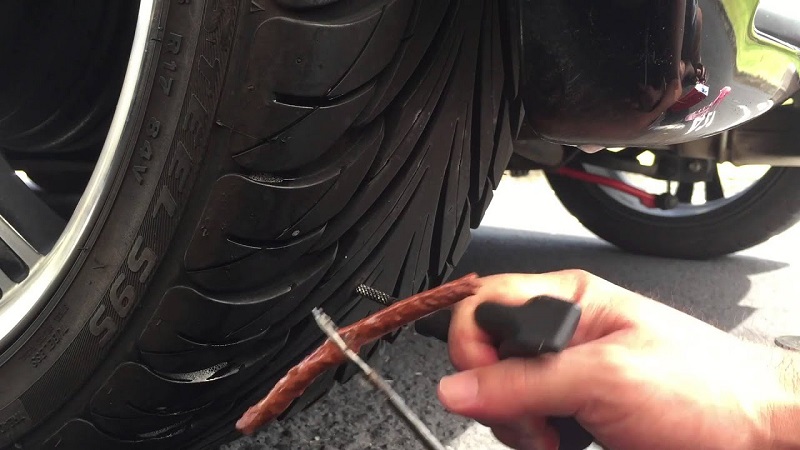 Such situations are fraught with damage to both the disk and the sidewall of the tire, in which case the disk will need to be corrected, and the tire repaired or even replaced. To avoid rim leaks, you need to inspect the rims every time you change tires. The loss of tightness occurs either due to corrosion or due to disc deformation, and not only steel, but also light alloy wheels can corrode. So if you see paint blistering or rust on the rim, the tires need to be put on rim sealant: when changing tires, this will be cheaper than the subsequent removal and re-tire to fix a leak on the rim.
Such situations are fraught with damage to both the disk and the sidewall of the tire, in which case the disk will need to be corrected, and the tire repaired or even replaced. To avoid rim leaks, you need to inspect the rims every time you change tires. The loss of tightness occurs either due to corrosion or due to disc deformation, and not only steel, but also light alloy wheels can corrode. So if you see paint blistering or rust on the rim, the tires need to be put on rim sealant: when changing tires, this will be cheaper than the subsequent removal and re-tire to fix a leak on the rim.
If you find a puncture, but there are no foreign objects in it, and you do not have a spare wheel and tire repair kits, there is another popular method of temporary "repair". You can screw a self-tapping screw into the found hole - if, of course, you have one. In extreme cases, you can look for a self-tapping screw in the cabin by unscrewing it from some interior detail. This method cannot be called reliable: it is unlikely to ensure complete tightness of the wheel, but at least it can help you get to the nearest tire shop.
And a couple more useful remarks. If the wheel is completely flat, then it is easier to inflate it without a spool: the latter must be unscrewed, then the tire must be inflated and quickly screwed back in. The fact is that the spool itself, when inflated, resists the compressor, and in the event of a loose fit of a flat tire to the disk, the power of a simple magazine compressor may not be enough, and the absence of a spool helps to increase air flow and facilitate the operation of the compressor. If this does not help, you can jack up the car by hanging a flat tire: this will improve the fit of the tire to the disk, and the chances of inflating the tire will increase.
On-Site Repair Methods
Now let's look at options for repairing a tire yourself using special materials that you should carry with you or, if a puncture caught you in the city, buy it at the nearest auto shop.
1. The most common, cheapest and easiest way to do it yourself is to install a raw rubber band.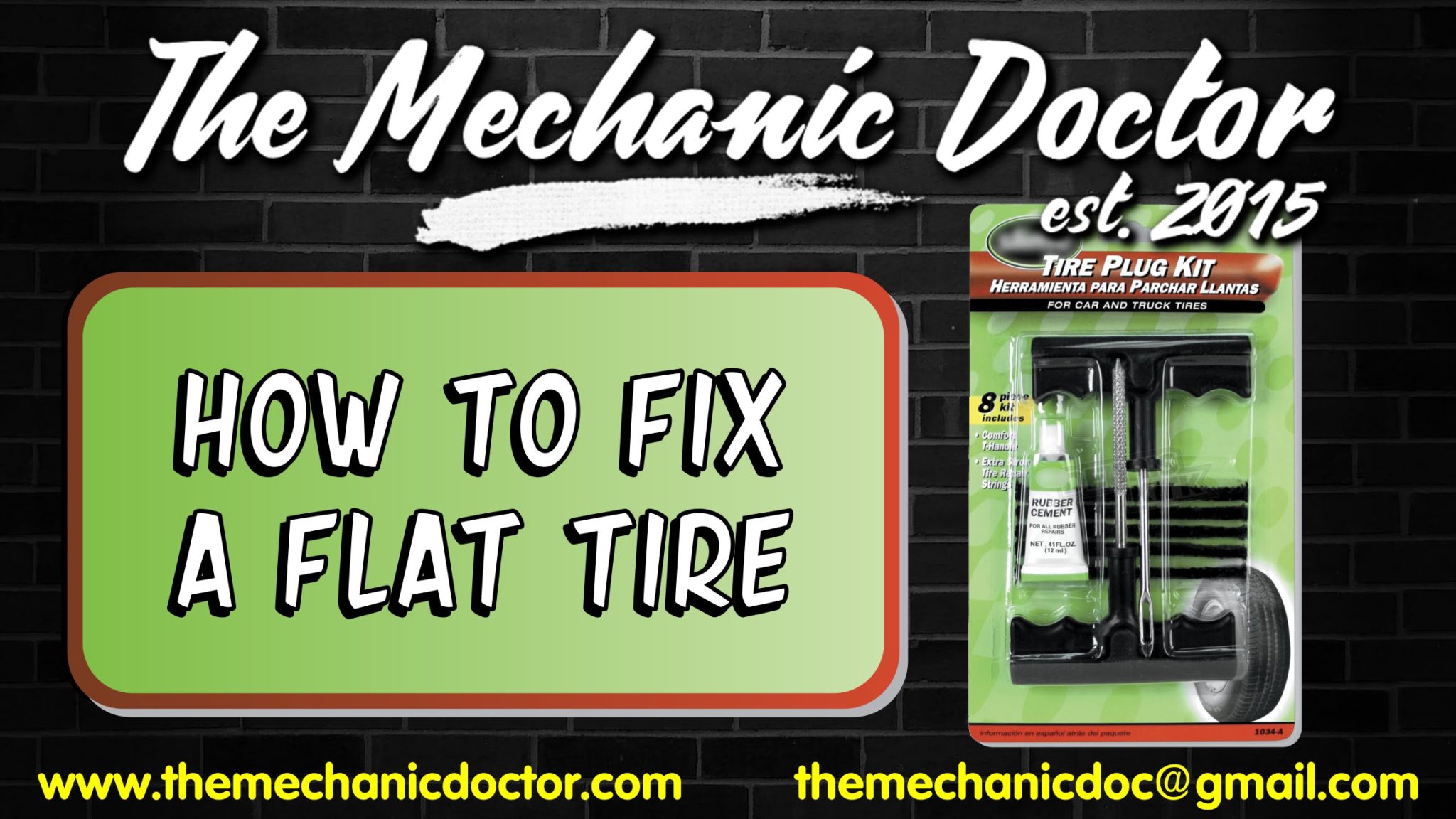 The harnesses are sold complete with an abrasive awl to expand the hole in the tire and improve the contact of the repair harness with its edges, as well as a needle for installing the harness and an adhesive to fix it and at the same time seal the puncture. When choosing a repair kit in a store, you should pay attention to the following nuances:
The harnesses are sold complete with an abrasive awl to expand the hole in the tire and improve the contact of the repair harness with its edges, as well as a needle for installing the harness and an adhesive to fix it and at the same time seal the puncture. When choosing a repair kit in a store, you should pay attention to the following nuances:
Install the harness in the following order. First, the found hole is expanded with an abrasive awl - you need to insert and remove it several times into the puncture site. Then the tourniquet is inserted into the eye of the needle, and glue is applied to it. After that, the needle with the tourniquet must be inserted into the hole in the tire and pulled out sharply - so that the tourniquet remains in the hole, and the needle comes out without it. If everything worked out, it remains only to cut the end of the harness flush with the surface of the tire and pump up the wheel.
If everything worked out, it remains only to cut the end of the harness flush with the surface of the tire and pump up the wheel.
The advantages of repairing with a harness are quite decent reliability, simplicity and low cost. On a well-repaired tire, you can drive for a long time, and if the repair site starts to poison, you can either replace the harness or have the tire repaired in a quality service. Among the minuses is the possibility of damaging the cord during installation, as well as lower reliability compared to “full-fledged” repair methods in a tire shop. Strictly speaking, a tourniquet is still a temporary repair, so if it is possible to pump up a wheel and get to a tire fitting, then it is better not to enlarge the hole in the tire and get to the experts.
2. The second repair option is aerosol liquid sealants sold in cans. To repair a punctured tire with sealant, you need to remove the foreign object from the puncture site, then pour the sealant into the wheel through the valve, twist it to distribute the composition inside the tire, pump up the wheel and drive several kilometers at low speed for the final uniform distribution of the sealant.
Among the advantages of this repair is the simplicity and less labor intensity compared to installing a harness. However, there are also disadvantages: the larger the hole, the higher the chance that the sealant will not be able to eliminate it, and such a repair can affect the wheel balance. Compared to a tourniquet, it can be considered even less reliable and preferable, but simpler.
Repair options at a tire shop
If you put on a spare tire and brought the wheel to a tire shop, you may also be offered several repair options. Consider the most popular with an indication of the advantages and disadvantages.
1. The first repair method is the same harness installation as described above. As we remember, the tourniquet refers to a temporary repair, so among tire specialists this method is considered bad form, but many workshops do not exclude it from the list of services. All the advantages and disadvantages are the same here: such a repair will be the fastest, simplest and cheapest, but less reliable than other methods.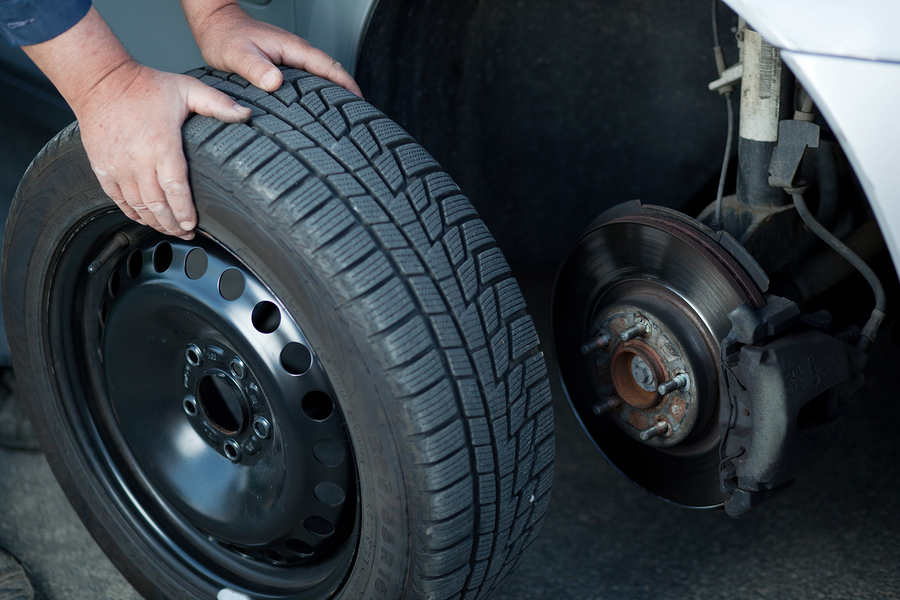 It is worth choosing it in cases where the price and / or speed of the procedure is more important to you than anything else. If quality is a priority, then it is better to fork out for the options listed below.
It is worth choosing it in cases where the price and / or speed of the procedure is more important to you than anything else. If quality is a priority, then it is better to fork out for the options listed below.
2. The second option for repairing a puncture is to install a patch on the inside of the tire, the so-called cold vulcanization. In this case, the tire is removed from the disk, the surface around the puncture is treated with an abrasive, and the damage is sealed with a special patch. This is a more preferred repair method than a tourniquet: it is more reliable and durable, especially in the case of side punctures, when not the thick tread part of the tire is damaged, but the thinner sidewall. Among the minuses, only a higher cost can be noted: in addition to the actual tire repair, you will have to pay for the removal and installation of the wheel (or do it yourself), tire fitting and balancing.
3. The third option is a "complex" of the first and second: installation of the so-called repair "fungus".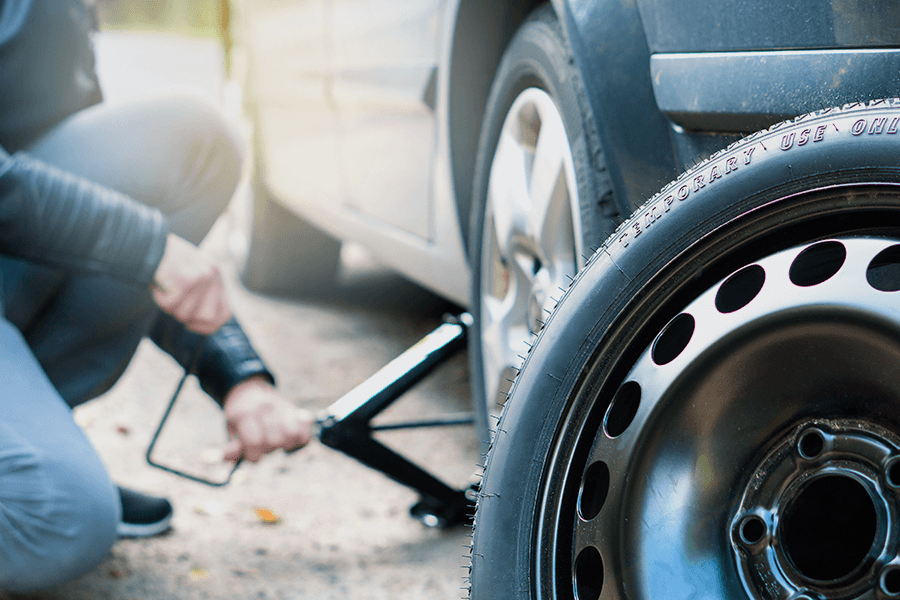 The “hat” of the fungus is a patch, and the “leg” is threaded from the inside of the tire to the outside. After gluing the patch, the excess part of the leg is cut off, as in the case of the tourniquet. Thus, not only the inner surface of the tire is closed, but also the hole itself. The advantages and disadvantages of this repair method are generally the same as those of a patch.
The “hat” of the fungus is a patch, and the “leg” is threaded from the inside of the tire to the outside. After gluing the patch, the excess part of the leg is cut off, as in the case of the tourniquet. Thus, not only the inner surface of the tire is closed, but also the hole itself. The advantages and disadvantages of this repair method are generally the same as those of a patch.
4. An extreme, “emergency” measure when repairing a punctured wheel is to install a camera in it. Typically, this method is used for tires that are no longer worth repairing, or “for reliability” after repairing a complex puncture. It should be understood that almost all modern tires are tubeless, that is, they are not designed to install a camera, so it’s not worth driving a wheel repaired in this way for a long time. Installing a tube is a temporary solution for riding until a new tire is purchased, and sometimes such wheels are left as spares. So this repair method can be kept in mind as a backup.
Finally
We have deliberately left out of this text such methods as combined repair of tires with a tourniquet and a patch and hot vulcanization. The first is used quite rarely and for specific damage, and it is enough just to know about its existence. Well, the second is used to repair serious side cuts, and it is not only rare, but also very expensive. The cut site in this case is prepared, filled with raw rubber and processed with a hot press for vulcanization. Equipment for this procedure is not available in every tire shop, and the cost of repair can be about half the cost of a new tire.
interesting popular questions
Articles / Practice Do No Harm: 10 Common Winter Car Mistakes In winter, the car is much more vulnerable than in the warm season. Many parts lose their flexibility, elasticity, become brittle. But a bit of attention and understanding on the part of the driver allowed ... 115 one 0 12/01/2022
But a bit of attention and understanding on the part of the driver allowed ... 115 one 0 12/01/2022
Articles / Statistics Not only parallel imports: why and how dealers join the fight for the secondary market With a shortage of new cars, the focus of many buyers has shifted towards used cars. The phenomenon is sad, but predictable and quite normal. Well, the second normal phenomenon ... 767 3 one 29.11.2022
Articles / Auto and technology Billions of tons of oil and An-24: the first 2,500 km of the "oil route" were completed We continue to follow the journey of Alexey Zhirukhin and Sergey Lysenko, who cover a route of 12 thousand kilometers along the path of oil from the well to the consumer.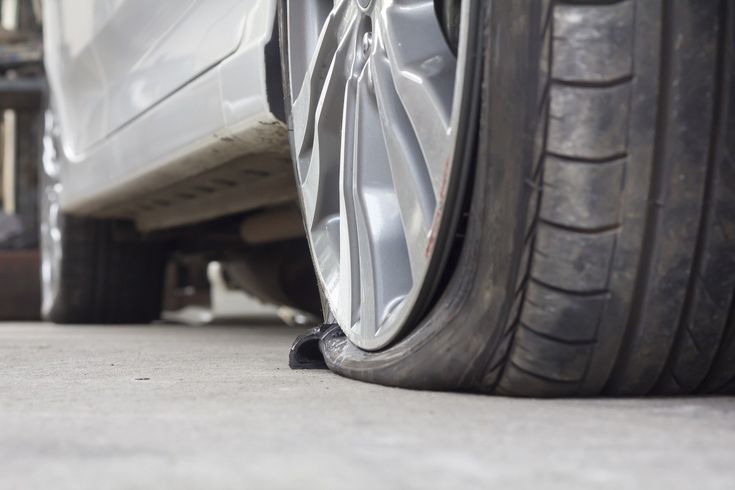 This is a joint project "Mezhre... 728 0 one 29.11.2022
This is a joint project "Mezhre... 728 0 one 29.11.2022
Test drives / Test drive Haval Dargo vs Mitsubishi Outlander: the dog is barking, the stranger is coming In the Haval dealership in the south of Moscow, life is in full swing: buyers look at cars, communicate with managers and sign some papers. While I was waiting for the test Dargo, the same cross... 17866 7 205 13.09.2022
Test drives / Test drive Motor from Mercedes, emblem from Renault, assembly from Dacia: test drive of the European Logan 1. 0 It would seem that what's new can be told about the second generation Renault Logan, known to every Russian taxi driver, as they say, up and down? However, this car has... 14342 ten 41 08/13/2022
0 It would seem that what's new can be told about the second generation Renault Logan, known to every Russian taxi driver, as they say, up and down? However, this car has... 14342 ten 41 08/13/2022
Test drives / Test drive Geely Coolray vs Haval Jolion: Free Cheese? If! Do you want to buy a car today with a full warranty, on credit at an adequate rate, without wild dealer markups? Now this is still a task, because a full-fledged chain of "representation - s... 11552 26 thirty 08/10/2022
A flat tire affects many motorists throughout the life of their vehicle. This can happen after an impact, due to poor tire pressure, or due to a foreign object. It can be a fast puncture that is easy to notice, or, conversely, a slow puncture that is sometimes difficult to notice.
This can happen after an impact, due to poor tire pressure, or due to a foreign object. It can be a fast puncture that is easy to notice, or, conversely, a slow puncture that is sometimes difficult to notice.
La puncture This is a disease that can affect any tire: a car tire, of course, but also a bicycle, for example. A puncture is determined by the wear on a tire, usually a punctured one, which then deflates.
But there are actually different types and causes of punctures, including:

We must also distinguish fast puncture , as it is due to shock, from what is called slow puncture . This is characterized by slow deflation, which is sometimes difficult to notice. In fact, loss of tire pressure while driving is normal (approximately 0.1 bar per month).
But a greater loss of pressure should alert you. Therefore, we recommend checking the tire pressure once a month.
When a puncture occurs suddenly, it is usually difficult to miss. Whether it's a curb crash or a tire explosion on the highway, you can't miss it. However, sometimes finding a slow puncture can be more difficult.
Every month your tires lose about 0.1 bar pressure. If you notice a significant and persistent loss of pressure, it could be a puncture. If it is installed in your vehicle, the tire pressure warning light may come on to indicate a problem.
Start by repeating the pressure and see if the fall continues. Once this is confirmed, inspect the tire (sidewall and tread) for any foreign objects that may have pierced it: a screw, a nail, various debris.
If that doesn't work, pour soapy water or Leak Detection Fluid on the tire and look for bubbles indicating air is escaping.
A puncture immobilizes the vehicle, especially if it is a quick puncture that will immediately deflate the tire. In order not to call a tow truck and not give yourself time to go to the garage, the tire can be repaired, depending on the nature of the puncture, or the wheel can be replaced. spare wheel or wafer , start by loosening the wheel nuts.
Then jack up the vehicle with the jack supplied with the spare wheel and finish removing the nuts. Then remove the wheel to replace it. However, be careful if it's a pancake: don't exceed 80 km / h and quickly replace it with a real tire.
Then remove the wheel to replace it. However, be careful if it's a pancake: don't exceed 80 km / h and quickly replace it with a real tire.
If it is a tubeless tire and the puncture is small and on the tread, it can be repaired tire sealant . If the gap is too large or located on the sidewall, you will have no choice but to replace the wheel.
To repair a puncture, remove the valve from the tire and place tire sealant on the nozzle. Pour it completely out of the tire and drive a few kilometers to ensure that the product is well distributed on the inside of the tire. Please note: Tire sealant is only a temporary solution.
Finally, there are puncture repair kits that can consist of Highlights , Plaster or Compressor and Blockage . Like tire sealant, these kits are temporary fixes that will get you repaired by the time you get to the garage to change your tire.
Like tire sealant, these kits are temporary fixes that will get you repaired by the time you get to the garage to change your tire.
Some punctures can be repaired: in this case, it is not necessary to change the tire immediately. Depending on whether you have to remove the wheel for repair, calculate the cost From 20 to 30 € about. This price includes tire balancing.
If the puncture cannot be repaired, the tire will need to be replaced. But be careful: the difference in wear of two tires on the same axle cannot exceed 5mm . In other words, both tires may need to be replaced.
The price of a tire depends on the brand, size and category (summer / winter). Count From 30 to 60 € for a tire. Add to that the cost of assembly and balancing (approximately 15 € per tyre) and possibly rims.